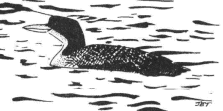|
The Hoylake “Bird Observatory” Bird Report for 2000-1 |
|||||
|
Back to Newsletter
Systematic list - The status line included for each species is adapted from the Cheshire and Wirral Ornithological Society's bird report. PLEASE NOTE: The original report had histograms showing the pattern of occurrence by half month over a five-year period at nearby Red Rocks (less than a mile away), they showed numbers which where the accumulated total for those five years. These where included in order to give a context to the records. Unfortunately in order to save space I have had to delete these graphs, if you would like to have the original report sent to you please contact me (click on e-mail on home page). *[The data are distorted by observer activity, greatest in April, May, September and October and patchy November to February and by frequency of recording observations; i.e all Whimbrel are logged but only occasional counts of Curlew were made historically]
Red-throated Diver Gavia stellata Scarce winter visitor
Black-throated Diver Gavia arctica Very scarce winter visitor
Great Northern Diver Gavia immer Very scarce winter visitor
One sat on the sea in calm conditions on Oct 1st. Presumably also present the day before when we had a large diver spp. drifting looming in and out of the fog on the incoming tide.
Great-crested Grebe Podiceps cristatus Fairly common resident and migrant
One was stranded on the beach on Oct 29th 2000.
Small Grebe spp. A small grebe, most likely a Slavonian Grebe flew west on Dec 22nd 2001. Unfortunately it was just a bit too far out to be 100% certain of the identity.
Fulmar Fulmarus glacialis Uncommon but regular offshore,
rare in winter We were "prospected" on May 26th and again on June 8th!
Sooty Shearwater Puffinus griseus Rare, irregular autumn migrant Manx Shearwater Puffinus puffinus Uncommon Coastal migrant
Recorded very regularly from May 17th until Sept 12th 2000. We made several large counts in early summer; 489 west on June 6th in a two hour evening seawatch, included 100 in view at once. This beats our previous record count from Red Rocks, however this was smashed again on June 23rd when we recorded 720, again moving west at a maximum rate equivalent to more than 1000 per hour. Birds were visible on most evenings through the summer where absence of heat haze allowed, though no counts bigger than 15 were made. In 2001 we recorded our first birds on April 7th 15th, when 14 moved west and there were ten on Apr 15th 2001. April records are very unusual in Cheshire. Birds were recorded throughout the summer, though less frequently in 2000. 100 on May 29th and 150 the following day were the largest counts of the spring/summer. Gales in September brought some large counts including 235 on Sept 7th. At least 30 of these flew across the wet beach, presumably having followed the gutter inside the East Hoyle Bank on the dropping tide. Our last record of the year came on Sept 15th when 17 moved west.
Leach's Petrel Oceanodroma leucorhoa Scarce autumn coastal migrant A series of gales in September 2001 brought excellent numbers of this species. In all we logged 483 between Sept 3rd and Sept 16th, with 147 on Sept 15th and 165 on Sept 16th the highest day counts. As with Manx Shearwater we saw a large number of Leach's Petrels cross the beach at low tide and even had one over the garden. One of the local Peregrines developed a habit of killing petrels that came ashore, taking six in 20 minutes on the evening of Sept 14th.
Gannet Morus bassanus Uncommon but regular coastal
visitor In 2001 the largest early year count was of 95 on Apr 22nd. In autumn 2000, 350 moved west in an hour on Sept 9th with a count of 420 in total. In 2001 numbers were generally lower, with counts mostly in the 40s to 60s. |

